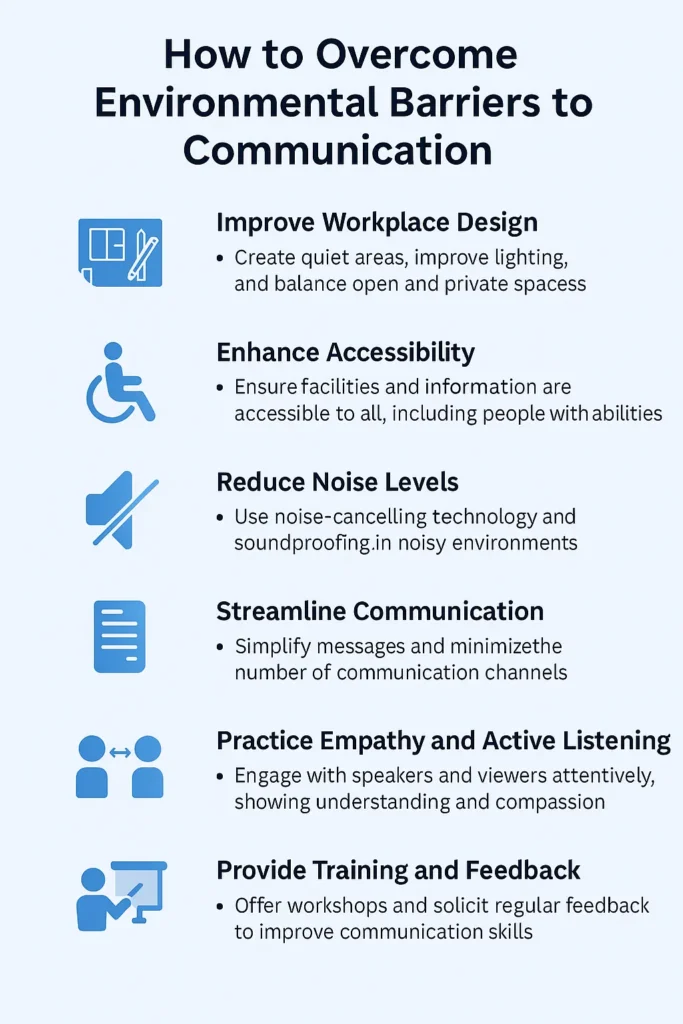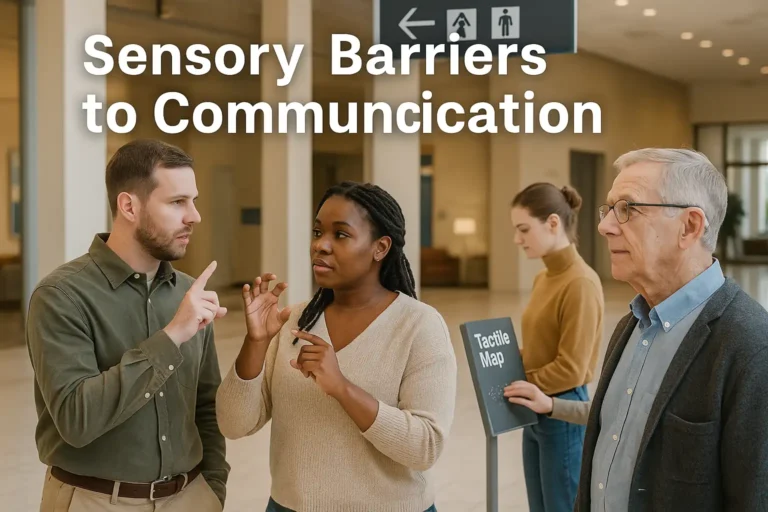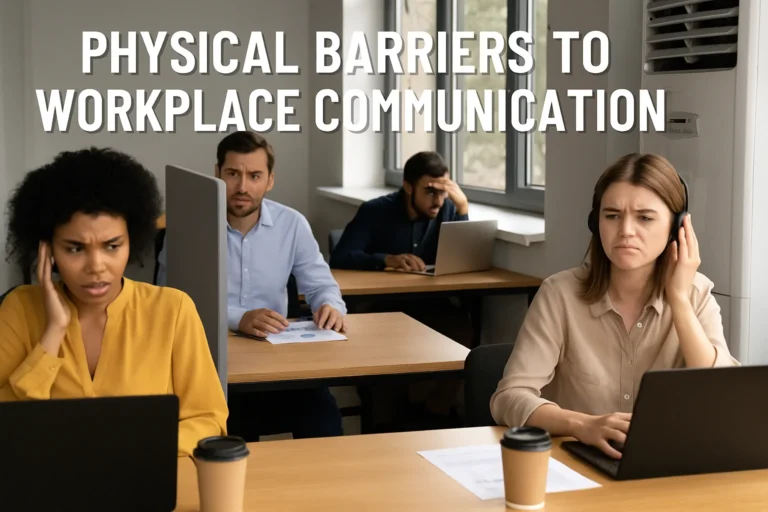Environmental Barriers to Communication
Have you ever left a meeting feeling completely confused, even though you were paying attention? Or struggled to get your point across in a noisy office, a dim classroom, or during a video call with a bad connection? If so, you’ve faced environmental barriers to communication—those obstacles in our surroundings that can twist, muffle, or block what we’re trying to say or hear. These challenges are more common than people realize, and they can affect everyone from students and teachers to managers and remote workers.
The truth is, no one sets out to create confusion. Yet, without the right conditions, even the clearest messages can be misunderstood. Today, we’ll look at what causes these problems, why they matter, and what anyone can do to make communication clearer and more successful—no matter where they work or study.
What Are Environmental Barriers to Communication?
Environmental barriers to communication are obstacles in the physical or social setting that prevent information from being shared accurately. These aren’t just background noises or bad lighting—though those certainly count. Environmental barriers include everything from layout, temperature, and technology, to issues with accessibility, time zones, and even the structure of an organization.
Experts at the Society for Human Resource Management (SHRM) agree that both physical and psychological surroundings play a huge role in how well messages are delivered and received. Sometimes, a barrier is easy to see, like a wall or a noisy street. Other times, it’s hidden—like an outdated policy or a lack of digital tools.
Common Types of Environmental Barriers
Let’s take a closer look at the most common types of environmental barriers you might encounter at work, in school, or even at home.
Physical Barriers

Physical obstacles are the most obvious. These include walls, doors, long distances, and objects that block sight or sound. A poorly designed office space, for example, can make it difficult for colleagues to share information quickly. Open-plan offices may sound like a good idea, but they often create distractions from constant movement and conversations.
Lighting also plays a huge role. Poor lighting causes eye strain, makes it tough to read or see facial expressions, and can even lower mood and energy. According to the Illuminating Engineering Society, well-lit environments support not just productivity, but also clearer communication and greater engagement.
Temperature and air quality are less obvious but equally important. A room that’s too hot, cold, or stuffy will distract people, lower their focus, and make it harder to follow a conversation or a presentation.
Noise and Distractions
Noisy environments are one of the biggest complaints in modern workplaces and schools. Whether it’s traffic, office equipment, hallway chatter, or even loud music, unwanted sound can drown out important information and make it nearly impossible to pay attention. Too much noise leads to misunderstandings, frustration, and sometimes even conflict.
Some organizations try to solve this problem with noise-cancelling headphones, acoustic panels, or designated quiet zones. However, the best solution is often a combination of smart design and clear policies. Setting rules for noise levels during meetings, or scheduling “quiet hours,” can make a big difference.
Technological Barriers
Technology is supposed to make communication easier, but when it doesn’t work as expected, it becomes a barrier. Outdated equipment, unreliable internet, or poor software design all get in the way. In virtual meetings, a laggy video call or poor sound quality can lead to missed cues, lost attention, and wrong assumptions.
Digital literacy—the ability to use tech tools comfortably—also matters. In a team where some people aren’t familiar with the latest software, messages may not reach everyone the same way. Training and technical support are important parts of removing these obstacles.
Accessibility and Inclusion Barriers
Not every environment is designed for everyone. Physical spaces and digital tools that don’t account for disabilities—like mobility challenges, hearing loss, or low vision—create barriers that are often invisible to those not affected.
Lack of ramps, confusing signage, missing captions on videos, or documents that aren’t screen-reader friendly can leave people out of the conversation. The Centers for Disease Control and Prevention (CDC) emphasizes that accessibility should be built into all communication, from emails and documents to meetings and events.
Organizational and Cultural Barriers
Sometimes, the barrier isn’t the room, the noise, or the tech—it’s the rules or traditions of the organization itself. Strict hierarchies, unclear policies, or complicated approval chains can slow down the flow of information.
Culture also plays a big part. Some organizations value open-door policies and regular feedback, while others rely on formal memos or rarely include everyone in key conversations. In global teams, time zone differences and cultural norms can also create “invisible walls” that block understanding.
Information Overload
While too little information can be a problem, too much information can be just as bad. Many people today face a flood of emails, texts, notifications, and background chatter. When there’s too much to process, it’s easy to miss important points, forget instructions, or simply tune out.
Managing the flow of information—through better organization, summarizing key points, and clear guidelines for urgent vs. non-urgent communication—can help everyone focus on what really matters.

Nonverbal and Spatial Barriers
Communication isn’t just about words. Body language, eye contact, and facial expressions all send signals. Poor lighting, awkward seating, or virtual settings can make it hard to pick up these clues.
The arrangement of furniture or the distance between people can affect comfort and trust. In some cultures, standing too close or too far can be taken as disrespectful or unfriendly.
Real-World Examples of Environmental Barriers
Noisy Office, Missed Connections
A large marketing firm in Chicago struggled with constant background noise in their open-plan office. Employees found themselves repeating information, missing key details, and feeling frustrated. After a workplace audit, the company added quiet rooms, set clear guidelines for phone calls, and installed sound-absorbing panels. Within months, both productivity and job satisfaction improved.
Poor Lighting, Poor Engagement
A university noticed students in certain classrooms seemed less attentive and more likely to miss visual cues. A lighting expert found that the rooms were dim and unevenly lit. Upgrading to brighter, more natural lighting led to better note-taking, more participation, and higher grades.
Tech Problems in Virtual Teams
A global software team relied on video calls, but slow internet and unfamiliar software meant many meetings ended with confusion. After providing high-speed connections and user training, the team reported fewer misunderstandings and felt more included.
Accessibility Gaps
A nonprofit held staff meetings in a building without ramps or elevators, making it impossible for an employee in a wheelchair to attend in person. Once the issue was flagged, management shifted to accessible spaces and added closed captions to virtual meetings.
Information Overload
An IT company’s employees received over 100 emails a day, many marked urgent. Important announcements got buried, and mistakes increased. Introducing daily summaries and tagging only truly urgent messages helped everyone manage their inboxes better.
How to Overcome Environmental Barriers to Communication
You don’t have to accept these challenges as a fact of life. Anyone can make changes, big or small, to reduce environmental barriers and help messages get through.

Architectural and Space Design
Thoughtful workspace design can improve both communication and comfort. Consider using a mix of open spaces and private rooms. Place meeting areas away from noisy equipment or high-traffic zones. Add acoustic tiles, comfortable lighting, and adjustable seating. Even rearranging desks to improve sightlines and reduce distractions can help.
Technology and Digital Tools
Invest in reliable hardware and software. Choose tools that suit your team, not just the latest trend. Make sure everyone is trained and supported as they adapt to new systems. Provide options like instant messaging, video calls, or collaborative documents, and encourage feedback on what’s working.
Accessible technology is equally important. Use software with built-in screen reader compatibility, closed captioning, and clear, easy navigation. Regularly check that digital content is accessible to all users.
Clear Communication Policies
Establish guidelines for how, when, and where to communicate. This can include quiet hours, rules about meeting locations, expectations for email response times, and guidance on inclusive language.
Encourage team members to speak up when something isn’t working—whether it’s noise, lighting, or a confusing tool. Open feedback channels lead to quicker fixes and greater trust.
Inclusivity and Accessibility Training
Offer regular training on accessibility and cultural awareness. This helps everyone understand different needs, reduces bias, and ensures no one is left out. Include practical tips, such as how to create accessible presentations, recognize signs of overload, or adjust communication styles for different cultures and abilities.
Managing Information Flow
Set clear priorities for communication. Summarize long documents, highlight key points, and use visual aids like charts or infographics. Use headings, bullet points, and plain language to help everyone stay focused. Regularly review what’s being sent out and cut down on unnecessary messages.
Building Psychological Safety
Create a culture where people feel safe to raise issues about their environment. When employees know their concerns will be heard and respected, they’re more likely to suggest helpful changes—whether it’s a noisy vent, dim lighting, or inaccessible materials.
Practical Checklist: Spot and Fix Environmental Barriers
- Assess the Space:
Check noise, lighting, temperature, and air quality in meeting rooms and shared spaces. - Audit Digital Tools:
Is software up to date? Is training available for all team members? - Ask About Accessibility:
Can everyone physically access meeting areas? Are virtual tools inclusive for all abilities? - Gather Feedback:
Use surveys or suggestion boxes to spot problems early. - Review Communication Flow:
Are messages getting lost or buried? Are important details repeated often? - Encourage a Culture of Inclusion:
Recognize and support the needs of people from all backgrounds and abilities.
Conclusion
Environmental barriers to communication can trip up even the best teams and brightest minds. These obstacles—whether physical, digital, or cultural—aren’t always obvious, but their effects are far-reaching. The good news? With awareness, the right tools, and a commitment to accessibility and inclusion, anyone can make meaningful improvements.
Clear, effective communication helps everyone feel included, focused, and ready to do their best work. Regularly reviewing your environment and listening to feedback will help you spot problems early and find the right solutions. Remember, making even small adjustments to noise, light, technology, or policies can have a big impact. Overcoming environmental barriers is more than just a “nice to have”—it’s essential for productivity and well-being in any workplace or learning setting.



